Rheumatologic Disorders: A Photo Essay
See clinical features of rheumatologic diseases including rheumatoid arthritis, systemic lupus erythematosus, dermatomyositis, psoriatic arthritis, scleroderma
Patients with moderate rheumatoid arthritis typically have diffuse swelling and limited joint mobility but no joint deformities. Extra-articular nodules and tenosynovitis may develop. Radiographic findings include periarticular osteopenia and minor cartilage destruction.
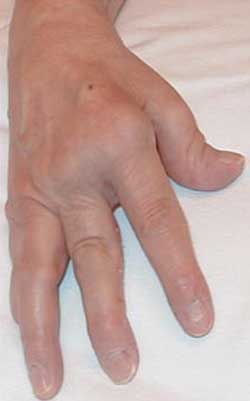
Image courtesy of Eugene Mochan, DO, PhD.
Click here for the next image
Systemic lupus erythematosus is associated with a variety of cutaneous manifestations that can occur on the lower extremities. Lupus panniculitis, shown here, reportedly occurs in 2% of patients. Indurated nodules involving arms, buttocks, head, neck, and thighs are characteristic.
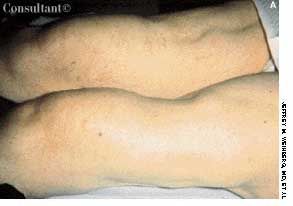
Image courtesy of Jeffrey M. Weinberg, MD and Victoria P. Werth, MD.
Click here for the next image
Dermatomyositis can present with erythema of the face, neck, upper trunk, knuckles, elbows, and knees. Poikiloderma may be noted in a photosensitive distribution. A patient's finger shows the characteristic manifestations of periungual erythema, ragged cuticles, and telangiectases.
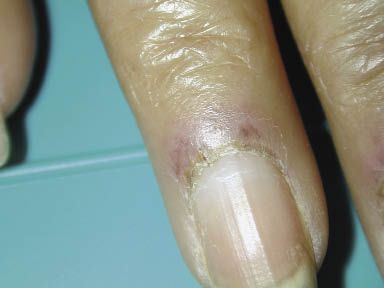
Image courtesy of Noah S. Scheinfeld, MD, JD.
Click here for the next image
Psoriatic arthritis develops in about 20% of patients who have psoriasis. The characteristic lesions of psoriasis-sharply demarcated inflammatory plaques with silvery scale-usually precede arthritis. They are usually found over the extensor surfaces of joints, on the scalp, in the umbilicus, behind the ears, and in the presacral area.

Image courtesy of David L. Kaplan, MD.
Click here for the next image
Tophi, the hallmark of chronic gout, result from the subcutaneous deposition of sodium urate. They may extrude chalky white material. This white lesion had been present on an older man’s thumb for many years. He sought medical attention when it became painful and erythematous. Gout was diagnosed after urate crystals were detected in fluid removed from the lesion.
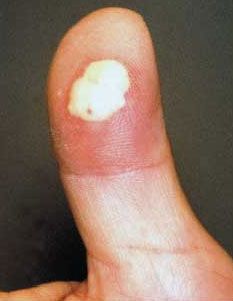
Image courtesy of Doug Davenport and Samuel G. Poser, MD.
Click here for the next image
A 54-year-old woman with red and painful eyes had a history of rheumatoid arthritis and dry eye syndrome. The use of preserved artificial tears provided little relief. Filamentary keratopathy, which resulted from the underlying severe dry eye syndrome, was the diagnosis.
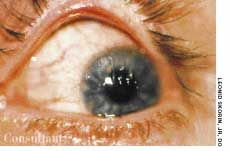
Image courtesy of Leonid Skorin Jr, DO.
Click here for the next image
Asymptomatic wartlike nodules had slowly developed on the fingers of both hands of a 57-year-old woman. Her physician noted proximal and distal interphalangeal joint changes consistent with osteoarthritis. Erosive osteoarthritis nodules are basically synovial cysts that extend outside the joints; they should not be confused with Heberden or Bouchard nodes.
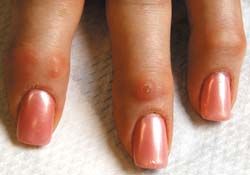
Image courtesy of Dmitry Shtrambrand, MD, of Passaic, NJ.
Click here for the next image
Patients with Wegener granulomatosis, a rare small-vessel vasculitis caused by inflammatory and granulomatous infiltrates, often have sinus tenderness and purulent or bloody rhinorrhea. Saddle nose deformity, shown here, is a characteristic result of nasal septal perforation.
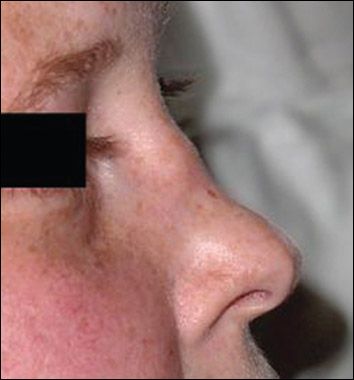
Image courtesy of Raja Shekhar R. Sappatibiyyani, MD.
Click here for the next image
A 64-year-old woman with an earlier diagnosis of scleroderma presented for a regular follow-up visit. The disease first manifested in the hands as Raynaud phenomenon and then sclerodactyly. The latter eventually advanced to the so-called clawhand, a disabling flexion deformity.
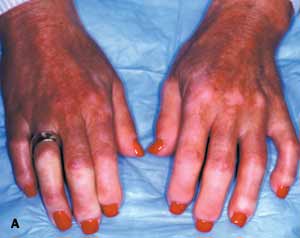
Image courtesy of Joe R. Monroe, PA-C, MPAS.
Click here to return to the first image.